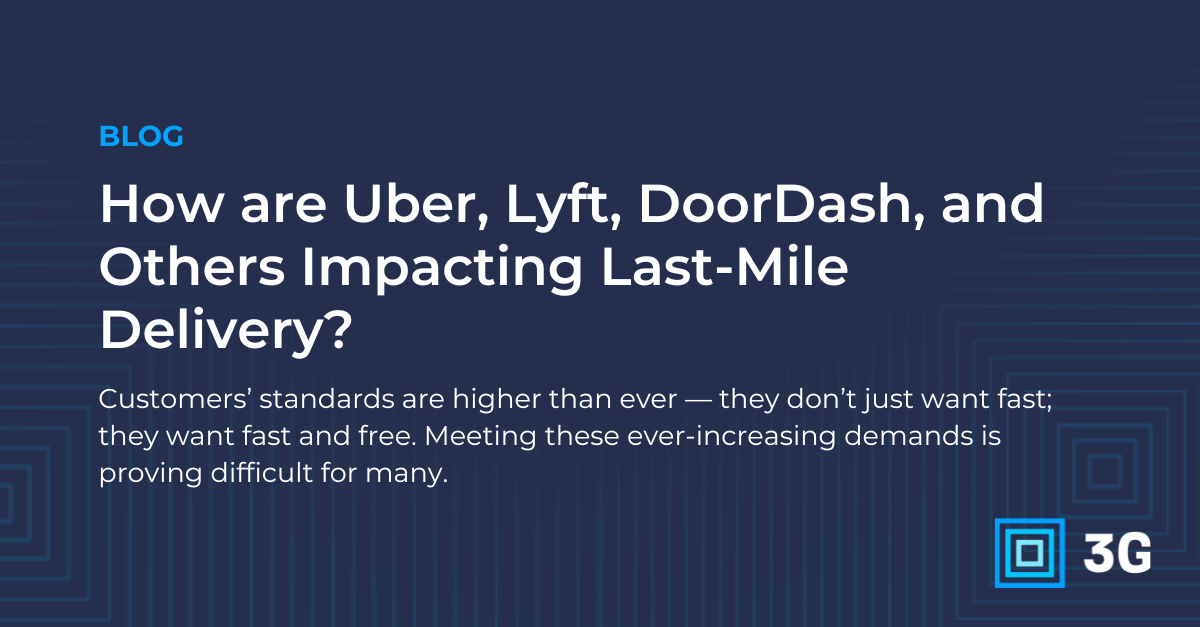Last-mile delivery is the final step in shipping an order to its ultimate destination (e.g., a customer’s residence). Since it’s the section of the delivery process that most closely involves the end user, prioritizing it is essential for maintaining customer satisfaction.
Unfortunately, it isn’t easy to get right. So much so that the phrase “last-mile problem” has become a sad staple in the industry, with X Delivery research noting that 56% of all abandoned baskets are left due to delivery concerns.
Customers’ standards are higher than ever — they don’t just want fast; they want fast and free. Meeting these ever-increasing demands is proving difficult for many. But companies like Uber, Lyft, and DoorDash impact last-mile delivery in previously unseen ways, like improving delivery speed, enhancing driver flexibility, and providing advanced tracking.
Naturally, these businesses face their fair share of challenges, but the seven areas of the sector they’re influencing are proving transformational for employees and customers alike.
7 Ways Delivery Platforms are Reshaping Last-Mile Delivery
#1 Speed and Efficiency
The demand for faster, more efficient deliveries has been rising for years. However, the advent of DoorDash and similar platforms has accelerated, with customers consistently expecting same-day/instant delivery.
From electronics to groceries to makeup to clothes, these providers leverage their extensive driver network to meet consumer demands effortlessly. With a mere click of a button, Americans can receive their order in as little as one hour, thanks to the platforms’ efficient process management.
Of course, the various retailers’ inventory and warehousing management protocols can slow some delivery times. However, most big-name brands that’ve partnered with such platforms have managed to simplify proceedings accordingly.
#2 Cost Optimization
Traditionally, shippers employ drivers to pick up parcels and travel their pre-defined routes to satisfy last-mile delivery requirements. But Uber, Lyft, and other gig platforms flip that on its head, providing a cost-effective solution for small- and medium-sized businesses.
All drivers are self-employed, meaning the company isn’t under any obligation to pay for vehicle maintenance, select routes, or pay wages when there isn’t work. Instead, drivers select the orders they can fulfill on the app, pick the packages up, and deliver the goods to the right customer. They receive payment for the work they’ve completed, keeping costs as low as possible.
By saving last-mile delivery dollars, companies can charge less for shipping, satisfying customers who want delivery speed and cheapness when shopping online.
#3 Flexibility
Flexibility is perhaps gig economy platforms’ most prominent impact on last-mile delivery. They offer the ability to scale the workforce according to ever-changing demand — when there’s more work, more drivers can step in on demand; when there’s less work, fewer drivers take the reins. The same goes for sudden order spikes.
Drivers also have the freedom to take on as little or as much work as they want to, helping them achieve optimal work-life balances, regardless of their situation.
#4 Technology Integration
The uptick in providers like Uber, DoorDash, and Lyft has rendered traditional track-and-trace technologies useless, leaving real-time visibility and on-demand communication in its place. The statistics speak for themselves:
- 90% of customers prefer brands that offer tracking options.
- 94% of customers are likelier to repeat purchases from brands exceeding delivery expectations.
- At least 83% of customers track online orders.
These platforms integrate advanced technologies into their apps, enhancing overall customer experience during last-mile delivery by giving them an easy-to-access, on-the-go way to check and track their order status in real-time.
#5 Market Expansion
Uber, Lyft, and DoorDash boast particularly massive market presences, letting them fulfill last-mile delivery expansion needs quickly and efficiently — a feat traditional logistics networks do not have the facilities for.
Historically, stringent onboarding and weeks-long communication must occur before shippers can fill any gaps in their delivery processes. But today’s fast-paced world doesn’t have time to sit stagnant for this long, and gig economy platforms are proving that, especially Uber. The company’s drivers can be cross-dispatched, allowing their gig-based workforce to complete various activities on the same day.
#6 Competition and Innovation
It’s no secret that these platforms have shaken up the last-mile industry. And while those bogged down in traditional processes may disagree, these modern solutions have provided some much-needed competition, fueling innovation in the space. As a result, service quality, delivery models, and efficiency rates are improving unprecedentedly.
Faster delivery offers a chance to build consumer loyalty. This rate of innovation could be the answer to increasing the percentage of firms offering two-hour delivery (currently sat at 19%) to do just that.
#7 Service Diversification
These platforms had relatively humble beginnings, offering ridesharing only. However, they have evolved into more than that, branching into delivery services and providing diverse last-mile solutions for businesses and consumers, like one-hour delivery, two-hour delivery, and pick, pack, and deliver.
Challenges Faced by Uber, Lyft, and Similar Providers
While Uber, Lyft, and similar platforms are undeniably revolutionary, they face a few challenges that could impact their abilities to have a prolonged impact on last-mile delivery:
- Regulatory concerns — Regulatory speaking, the gig economy operates in pretty murky waters. It has raised many concerns among advocacy groups and policymakers regarding worker classification, labor rights, and benefits. Therefore, businesses using gig workers for last-mile deliveries may face scrutiny and legal challenges as time goes on.
- Sustainability woes — Sustainability goals are hard to manage using a gig fulfillment process. Drivers may deliver packages separately, taking many trips to meet strict deadlines. While this ensures customers receive their packages quickly, it’s a sure-fire way to put environmental goals on the back burner. Since only 38% of consumers worldwide say they believe retailers are doing a good job using sustainable delivery protocols, according to Descartes data, maintaining eco-friendliness is more critical now than ever.
- Labor disputes — Gig workers cannot take legal action against the contracted corporation during labor disputes. With Biden’s recent revision to the Fair Labor Standards Act’s definition of an employee, last-mile providers operating on a gig-based system may need to alter their business models.








